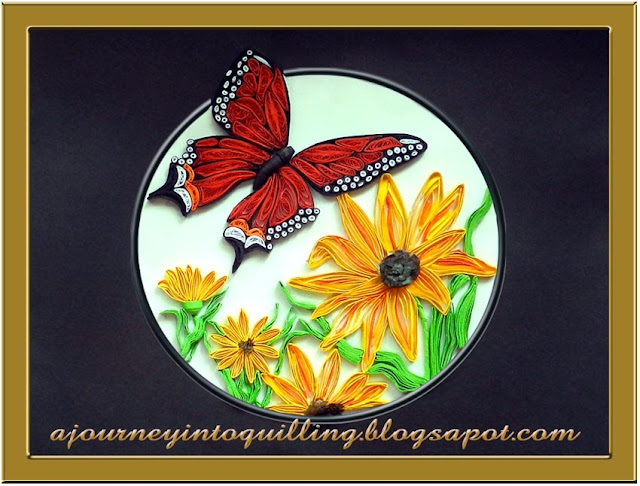This tutorial is on how I shape pegs (tight coils) to make receptacles for flowers, thorax and abdomen for butterflies. You do not need special molds or tools and as you can see you can get cone or bell shapes very easily.
To learn fast, read this tutorial in full to get an idea of the steps and concepts then read it again while you follow the steps creating the item. Then try the item out without looking at the tutorial and you will remember it without effort.
Tools That Are UsefulI find the above tools invaluable for quilling small items and for shaping pegs. The narrow tip glue applicator is an empty fabric 3d paint applicator which I filled with glue. When I want just a tad of glue I merely use gravity and do not press the bottle. When not in use cover the tip with wet sponge or a cap.
A toothpick sharpened with a blade is useful for rolling the pegs without large holes in the center. I sharpen it to increase friction so that I can turn the toothpick to roll the strip . Roll the toothpick over the end of the strip, applying a little pressure so that the strip rolls around the tip, then roll the strip around the sharpened end using thumb and forefinger. Once a portion of the strip is wound round the toothpick you can roll the toothpick to finish the peg and glue it. Ensure that you do not wind it too tightly. What is most important is the tension which should be neither too tight or too loose. If you find the inner coils are too tight allow a minute unwind and then glue it.
You will need to practice a bit if you are using a toothpick. You can even wind it with your fingers to complete the peg. The toothpick is only required to ensure the inner hole is small as in the pic below.
Always use 2 strips to make the peg for stronger more shapely objects. Once you have rolled the peg and glued it, roll over the top with your quilling tool to flatten it uniformly.
Now to shape it. Slightly concave the peg with the ball of your finger, then hold the peg between thumb and forefinger as shown.
Now press the peg a little and move your forefinger forward and backwards and as you do that, the peg will start cupping downwards.
Then move you fingers a tad lower on the cupped coil and repeat the action till about 1mm of each coil is visible.
Now if you want a bell shaped cup,insert a cotton bud or a round ended cylinder that fits and you can keep it on top of a foam and make anticlockwise turns while pushing it gently down. The anticlockwise movement makes it unwind and rounded so do not over do it as it will come out. When you push it down it will round the end like the pic.
If you want cones you can push the coils out with a narrow cylinder and the roll it clockwise slightly to tighten the coils.
Another point of note is the breadth of the strip. Thinner 1mm or 2mm strips make more rounded small objects while 4mm and over strips will make more cone shaped small objects.
Butterfly Body
If you want a cone shaped object which is rounded on top like in the pic for butterfly bodies, then you
make the coils and first push the bottom part down with a toothpick like a cone and then roll the top between your fore fingers and thumb with short pushes forward (clockwise) and long pulls backwards.The long pulls will round the top coils while the short pushes will balance the tension.
Or, you can keep the peg on a soft surface and push it with your finger to make a cup shape and then once the top is rounded you can gently push the bottom with a toothpick to make a shape resembling a funnel. Then you can elongate the rounded top slightly by rolling a cotton bud around the surface from the inside.
Curved Cone
Make a cone or rounded cone and then work a toothpick or cotton bud from the inside rubbing one side out slowly forward and backwards, so that the coils are exposed more on one side to curve the cone.
Make sure you apply glue on the inside and allow it to dry well before using your shapes. If you have glued them well you can cut them open once dry and they will still hold the shape. Always use a paintbrush to apply the glue uniformly.
The best way to learn is to make a few pegs and experiment how it shapes with various movements both on the inside and outside of the cones. You can always use molds or plastic palettes to make rounded shapes.
The use of cotton buds to shape has the advantage of allowing you to get any size by wrapping more cotton around it. The foam prevents the bottom from getting pushed out while rounding it.
Keep checking your coils to ensure that you have not pushed out any area too much and each coils exposes only half to 3/4ths of the breadth.
I hope this has been helpful. If it was, I would love to hear your comments.

.JPG)
.JPG)
.JPG)
.JPG)
.JPG)
.JPG)
.JPG)
.JPG)
.JPG)
.JPG)

.JPG)
.JPG)
.JPG)
.JPG)
.JPG)











.JPG)
.JPG)
.JPG)
.JPG)








.JPG)
.JPG)
.JPG)








